The Lost Synagogues
Ironically, there is a book called "The Lost Synagogues of Brooklyn" which was published in 2009 by Ellen Levitt. Her focus was on buildings that were still standing. This page is to help track the ones built in East New York but are now gone. It is a work in progress, and any additional information is appreciated.
Click on thumbnails to enlarge. <>
|
Chevre Sfard Anshei Poland
Address: 524 Snediker Avenue Block: 3833 Lot: 32
Founding of Congregation: 1919
Year Constructed: 1915 Demolished:between 1966 and 1980
Notes: The unique brickwork was used all along the block; I assume this was converted from a private residence. The CO for the synagogue was dated 1928. The sign above the doorway was in Yiddish. It appears it was taken over by the city for a tax lien and eventually sold to the Gospel Church of Christ, which in turn sold the property in 2003. The other buildings have survived and look quite good-the new construction on the far right (2006) replaced the synagogue. |
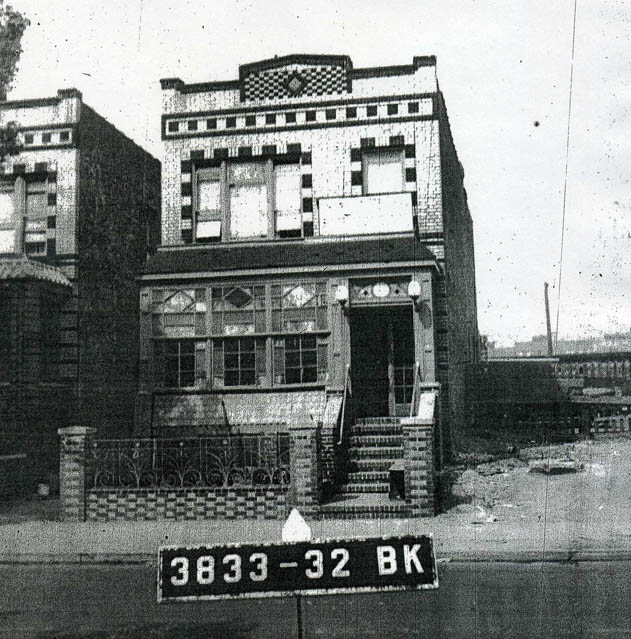 |
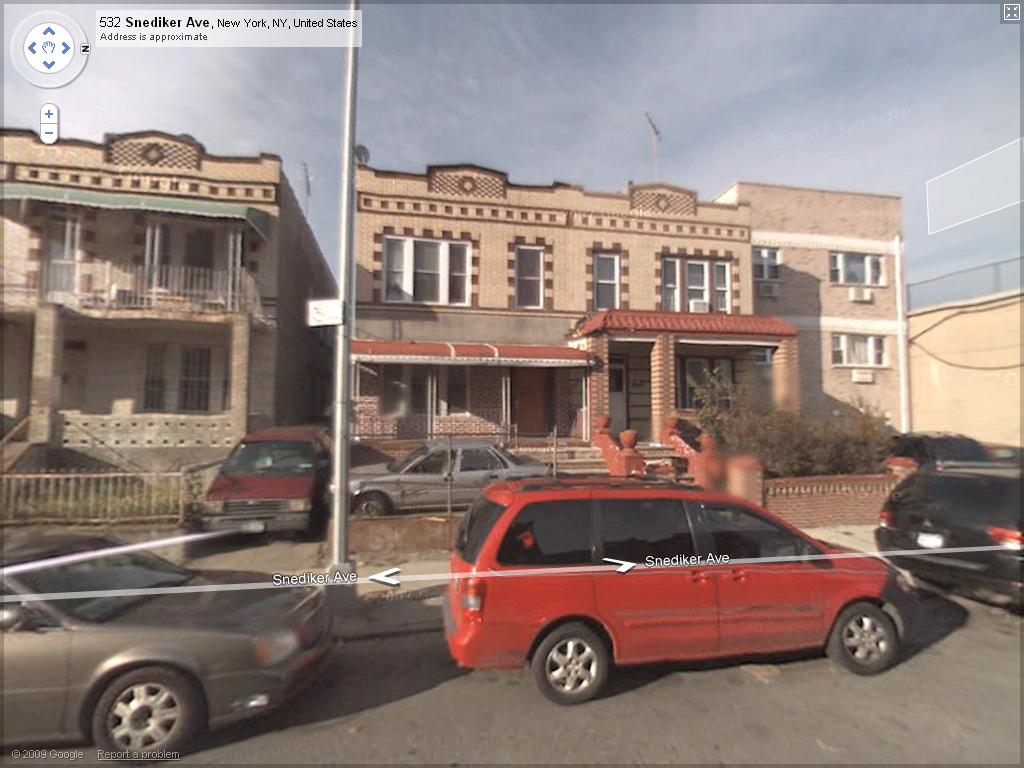 |
Congregation Eliezer of East New York
Address: 133 Hinsdale Street Block: 3716 Lot: 12
Founding of Congregation: 1906
Year Constructed: 1910 Demolished:2013
Sold about 1967 to First Born Temple of the Living God Congregation, the building was demolished in 2013. The 1940 tax photo is on the left; Demetrius Pestun supplied an image in 2007. |
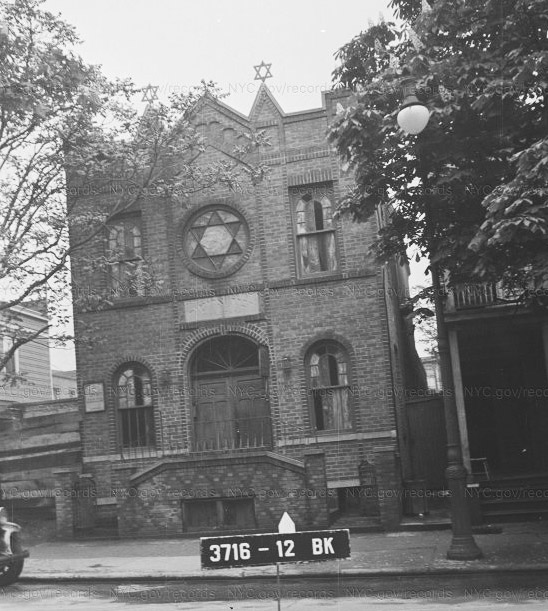 |
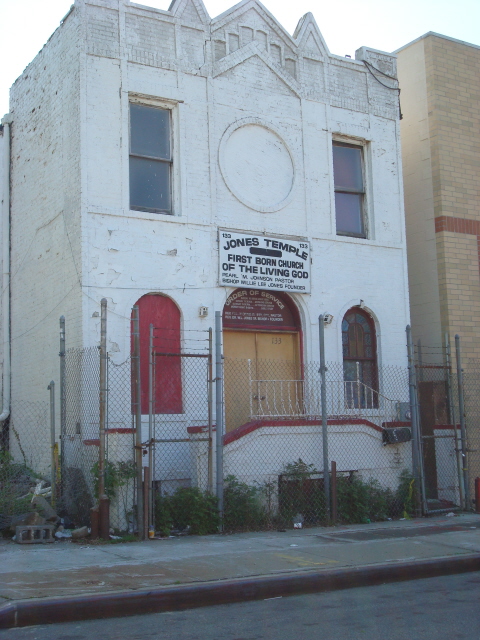 |
Congregation Sephardim
Address: 621-623 Hinsdale Street Block: 3867 Lot: 23
Founding of Congregation: Unknown
Year Constructed: 1925 Demolished:between 1980s
Notes: The Brooklyn Eagle reported the congregation's plans to build the synagogue and adjoining 3 story structure for $5,000 in 1925. It was sold in 1966 to Mason Temple Church of God in Christ. Demolished for housing in the 1980s. . |
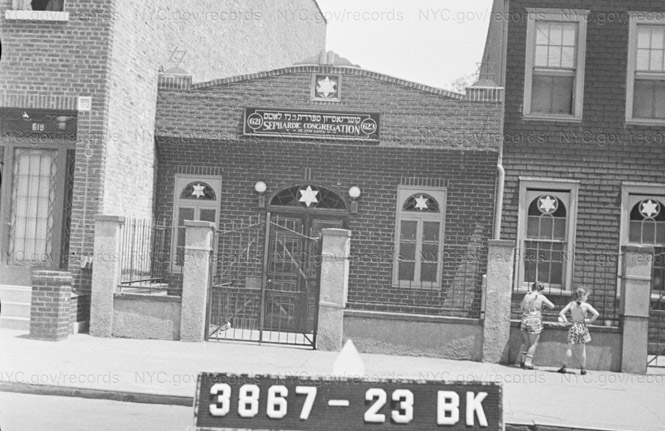 |
Agudath Achim Sfard of East New York
Address: 367 Williams Avenue Block: 3785 Lot: 20
Founding of Congregation: Unknown
Year Constructed: Unk Demolished:abt 1972
Also identified as the Agudeth Achim Sons of Rabbi Chaim Halberstam Congregation in the 1940 WPA survey and 1959 NYC report. Some shuls were a little more obscure as they were established in residential buildings. This and the surrounding buildings were cleared for the Unity Plaza Houses in 1972. |
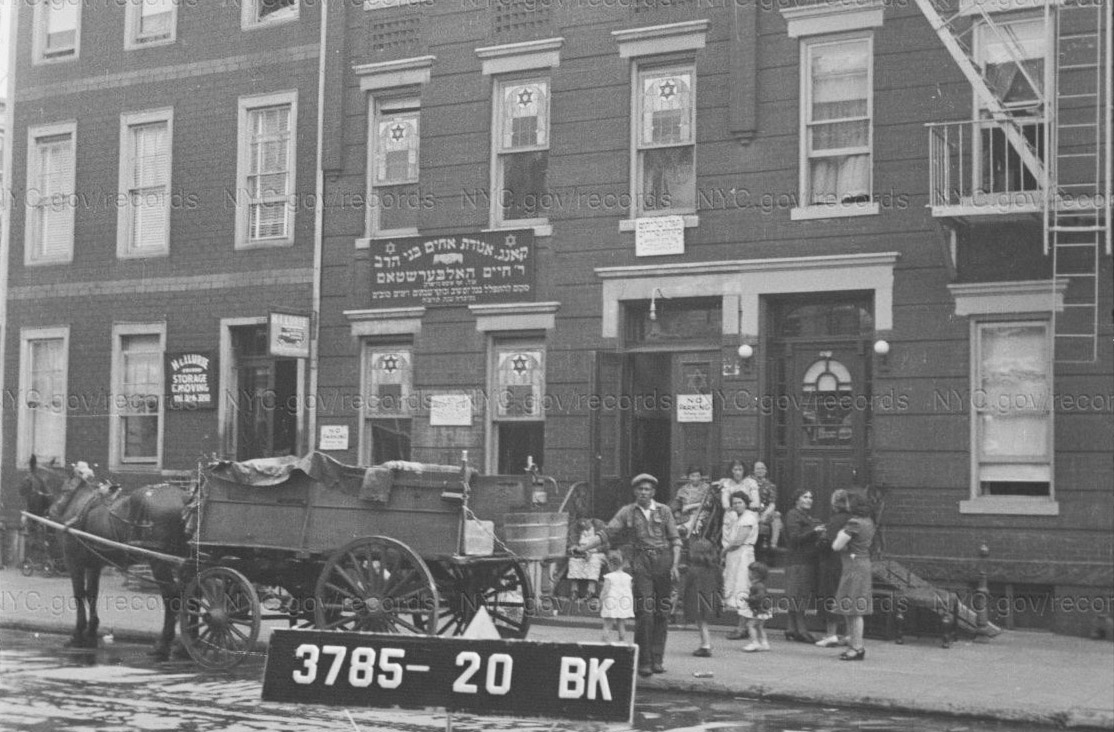 |
Umaner Congregation
Address: 285 Hinsdale Street Block: 3767 Lot: 13
Founding of Congregation: Unk
Another converted residence, little is known of the congregation. Uman is a city in Ukraine, I'm guessing the congregants had immigrated from there. The building was sold in a referee's sale in 1966 and was gone by the 1980s. . |
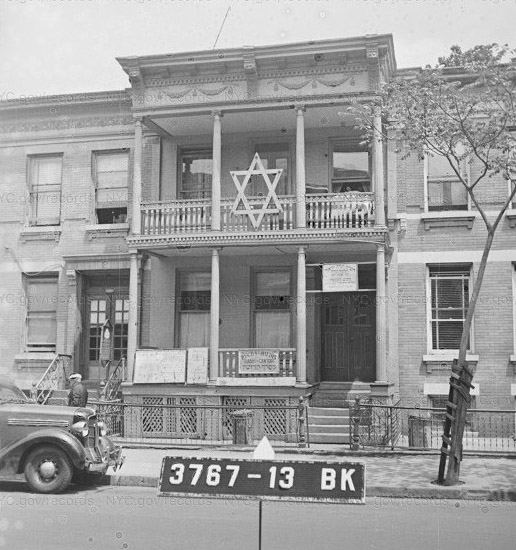 |
|
Chevre Bnai Abraham
Address: 348 Alabama Avenue Block: 3768 Lot: 46
Founding of Congregation: Unk
Year Constructed: Unk Demolished:Unk
A simpler residential conversion. Sold to the Exodus AME Church in 1962. Since demolished. P.S. 328 was constructed in this location in 1967. |
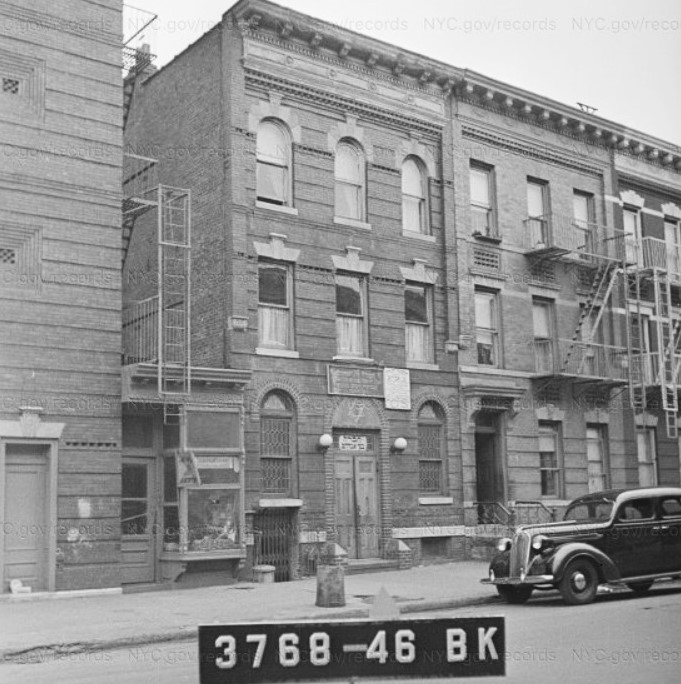 |
|
Muged Avruhum of East New York
Address: 437 Schenck Avenue Block: 4044 Lot: 10
Founding of Congregation: 1913
Year Constructed: Unknown Demolished: Unknown
Notes: Led by Rabbi Israel Shurin. The building was sold in 1967 to the Mount Zion of Christ congregation. Replaced in the 1990s by 2-story attached multifamily units. On the 1929 Plat maps. |
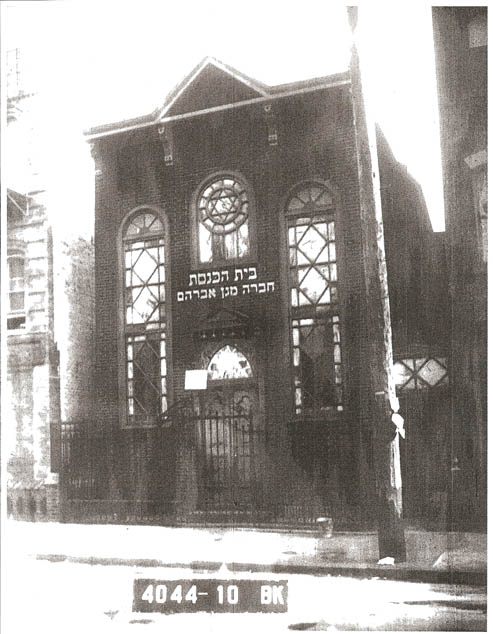 |
|
Chevre B'nai Jacob Anshei Sphard
Address: 276 Pennsylvania Avenue Block: 3737 Lot: 32
Founding of Congregation: 1906
Year Constructed: Unknown Demolished: 1972
Notes: Building was replaced by the Grace Towers project in 1972. On the 1929 Plat maps. |
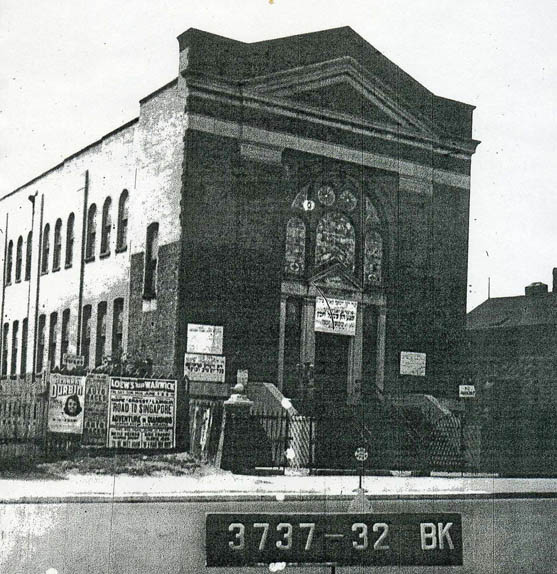 |
|
Glory of Israel Hebrew Institute
Address: 377 Pennsylvania Avenue Block: 3772 Lot: 6
Founding of Congregation: Unknown
Year Constructed: Unk Demolished:abt 1970s
The address (alternatively 363, or 371, or 377) of this institution differs depending on the source. This may be due to the oversized lot which covered more than one address. The name is also a source of confusion. The building housed a school/youth center as well as a synagogue. The school was known as Boys' Congregation of Talmud Torah Tifereth Israel. David Diamond offered some background; "It was a huge building and was a very active and well attended youth service on the lower level and a beautiful large synagogue on the upper level.. there were youth activities Saturday nights...Adjacent to the building was a large open area for playing." The building was cleared in the 1970s and the current structure houses an annex for P.S. 149. . |
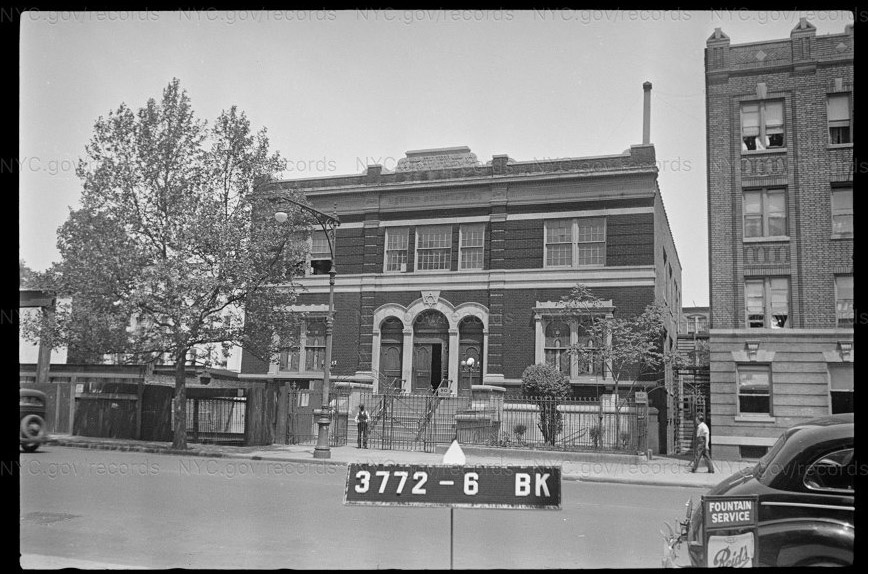 |
East New York Jewish Center Talmud Torah
Address: 374 Vermont Street Block: 3756 Lot: 31
Founding of Congregation: Unknown
Year Constructed: Unknown Demolished: Unk
Notes: Taken over by city via tax lien, 1970. Building gone by 1980. Listed in 1919 Jewish American Yearbook. Menachem Nussem, who attended the synagogue, informed me the Rabbi at that time was Rabbi Yitzchak Pupko. Rabbi Pupko was held in very high esteem as a scholar of both civil and religious Jewish law. |
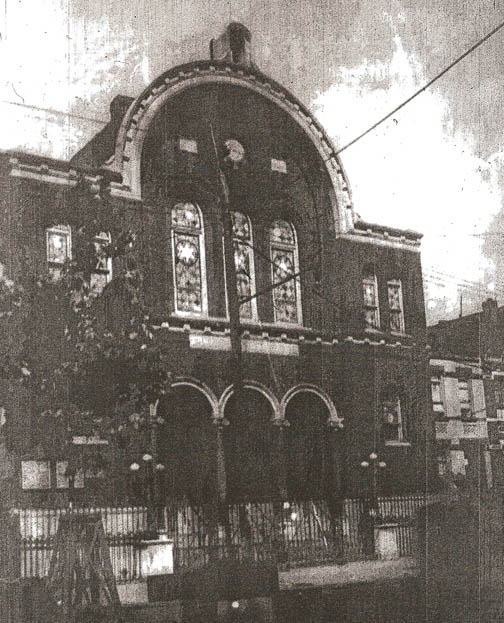 |
|
East New York Talmud Torah
Address: 872 Dumont Avenue, southwest corner, Barbey Street and Dumont Avenue Block: 4076 Lot: 25
Founding of Congregation: Unknown
Year Constructed: 1912 Demolished: 1970s
Notes: Taken over by city via tax lien, 1973. Building gone by 1980. Listed in 1919 Jewish American Yearbook. Architect: Lawrence J. Frank. Cost:$10,000. The site was included in the mass transfer of city lots for the Nehemiah Houses plan in 1988. The plan depended on a low cost construction approach involving a long row of two-story attached units. I'm assuming the orientation of this lot, facing Dumont, made it impractical to include in the plan. |
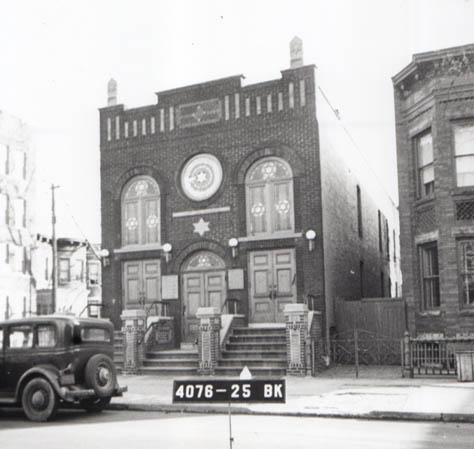 |
|
East New York Talmud Torah
Address: 811 Dumont Avenue, southwest corner, Barbey Street and Dumont Avenue Block: 4076 Lot: 25
Recollections of Harold Moskowitz: "The building was entered on Dumont Avenue by climbing four steps from the pavement and walking through a doorway with two brown oak doors in the southern direction toward Livonia Avenue. The interior walls finished with plaster over wood lathe. The building was surrounded by a sturdy , adult-height iron fence with sharp, spiked pickets and posts all painted green. Between the fence and the Barbey Street wall, was a 5 to 6 foot wide walkway area of cement with embedded glass circles to admit extra light to the full-size full length cement floor basement. The basement contained separate lavatory facilities for men and women congregants. It also contained an underground passageway which connected with the basement of the Hebrew School.
The synagogue building had two stories. The men worshiped on the lower level. There were three rows of pews; one along the western wall of double-hung windows, one along the eastern wall, and one in the middle which was wider than the two wall rows. There were armrests at the ends of each pew. This middle row terminated about five feet in front of a raised platform with a railing around it. A few steps led up to this platform (the "bemah") where the rabbi sat and congregants at appropriate parts of the service could be called up to the Torah to chant the required part for that specific day's service. A few feet behind the "bemah" was the Holy Ark where the Torah was kept when not being used in a service.
The women, according to the Orthodox Jewish tradition, worshiped separately from the men. After passing through the front entry door, they could ascend to the womens' gallery on the upper level by way of a staircase starting on either the left or right side of the entry doors. As on the lower level of the sanctuary, there were rows of pews along each outer wall. However, there was no middle row. Instead, there was a floorless open area so that the women in the gallery would be able to hear and see the service going on below them. There was also an area between the top of the two staircases and the curved railing for standing room for those women who just wanted to be there to experience the sounds and "togetherness" of the High Holy Day services.
Above the womens' gallery was a concave ceiling which curved from the east wall to the west wall for the entire length of the building. It was finished with plaster and was painted light blue. A mural painter had been hired to decorate the ceiling with white stars and portrayals of angels in flight. The southern wall behind the Holy Ark had a large multi-color stained glass Star of David about two-thirds of the way up the wall. The floors were of unfinished rough oak of the kind I often saw in neighborhood stores. " |
Chevre Mishnayes East New York
Address: 335 Sheffield Avenue Block: 3771 Lot: 15
Founding of Congregation: 1909
Year Constructed: Unknown Demolished: Unk
Notes: One of the earliest Jewish congregations in East New York Was Congregation Puchowitzer, founded in 1898. It was listed at this address in the 1942 WPA survey. The Museum of Family History lists Chevre Mishnayes at this address, they would move to 236 Wyona (see below). I had given up on finding a photo when Andrew Tomasello sent me this image he took back in 1958 as a young boy living across the street at 346 Sheffield. Andrew recalls; "It definitely was a strange building, stand alone, gray shingles ...I'm thinking asphalt...with this adjoining weed-filled lot. On Friday evening the interior was well lit with fluorescent lights and then some. The Windows had no curtains and always looked clean. The older kids in the neighborhood would sometimes score a dime to turn the lights on and act as shabbas goy. I always thought that would be a great job for me, but we moved out in August 1961, when the junkies and burglars would run across the roof in their escape through another building on the block."
Records show the city acquired the property in 1973, and cleared it prior to the 1980s tax photos. Nehemiah Housing now occupies the block.I have added the 1940 tax photo as well. |
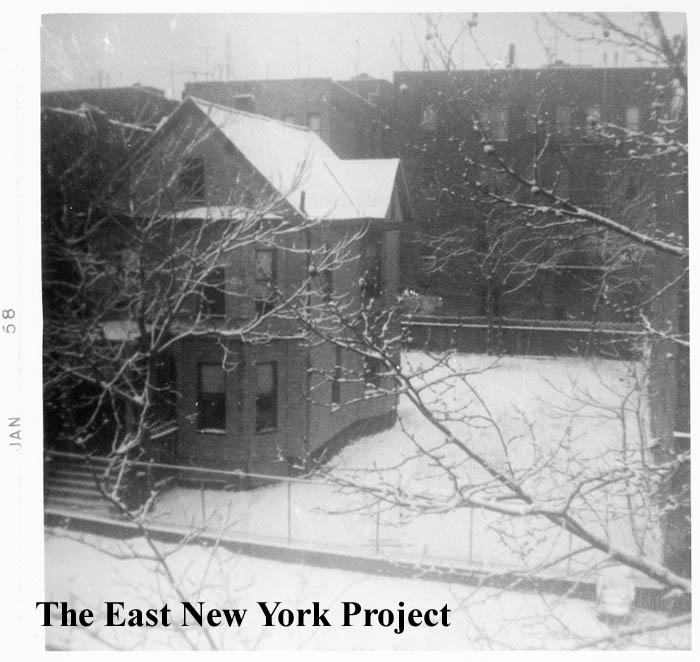
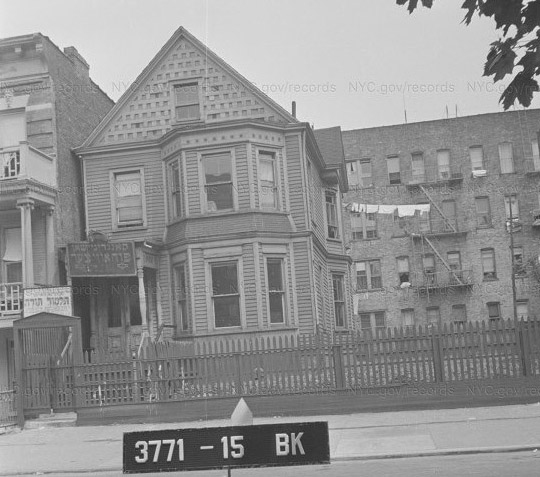 |
Chevre Atehereth Zvi of East New York
Address: 495 Jerome Street Block: 4046 Lot: 4
Founding of Congregation: 1920
Year Constructed: about 1930 Demolished: Unk
Notes: First home was located at 482 Barbey Street. Still at 495 Jerome in 1959. |
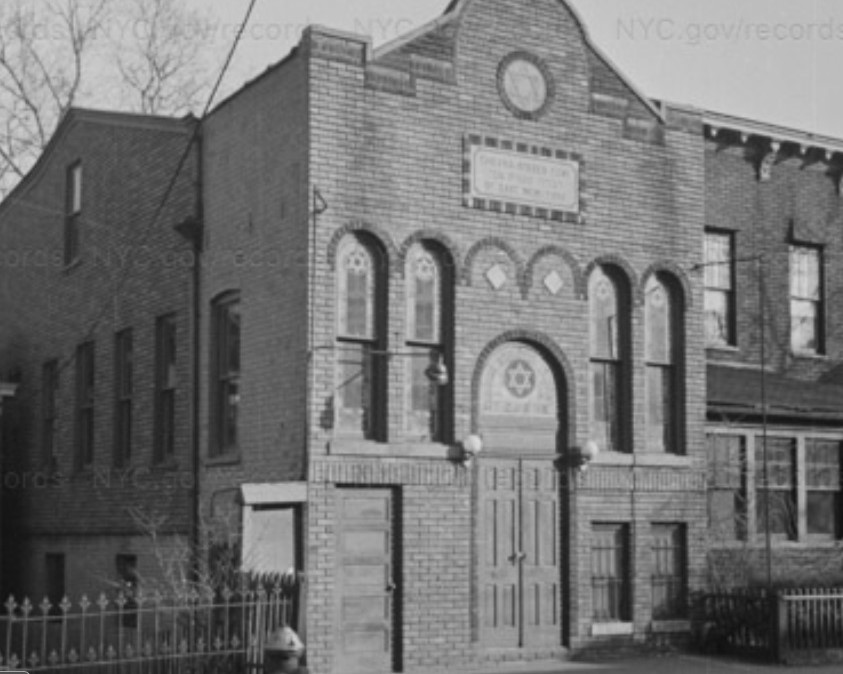 |
|
Crowning Glory of Israel
Address: 481 Ashford Street Block: 4048 Lot: 16
Founding of Congregation: 1909
Year Constructed: 1912 Demolished:abt 1970s
Cornerstone laid in 1912, the Congregation was located at 934 Blake Avenue prior. The Talmud Torah is the building on the left, constructed 1919. The City appears to have acquired the property in 1973 and it was demolished not long after.The location is a courtyard today. |
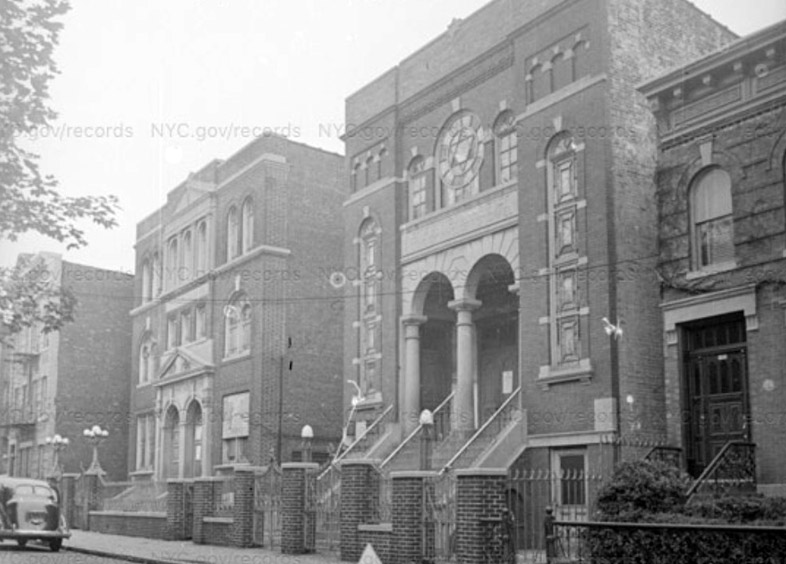 |
Talmud Torah Ohev Zedek
Address: 256 Berriman Street Street Block: 4037 Lot: 22
Founding of Congregation: 1909
Year Constructed: Unknown Demolished: 1991
Notes: This entry had to be significantly redone after Dr. Steven Turner tipped me off that the location was incorrect in the WPA survey. Dr. Steven Turner recalls the synagogue was between Sutter and Belmont Avenues. His great-grandfather, Gaul Hoffeld founded the synagogue, and his 97-year old mother was born on Berriman Street a block away. The congregation started with families from Galizia, and the two-story brick building had an apartment on the second story for the shamos. 103-year old (God Bless!) Miriam (Siegfried) Wilder provided helpful background via her great-nephew; "She told me that her son's Bar Mitzva was in the synagogue in the late 40s. She described the Berriman St. synagogue as a small Orthodox synagogue located in a storefront." After browsing the tax photos I identified the correct location, 256 Berriman Street, as Dr. Turner had suggested. It was sold in 1968 to the Calvary Healing Temple Ministry, pictured on the right in the 1980s. It was torn down in 1991 for 2-story housing. |
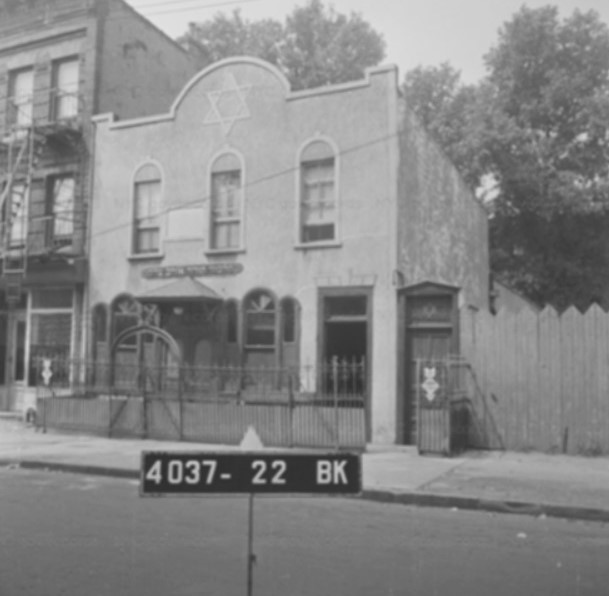 |
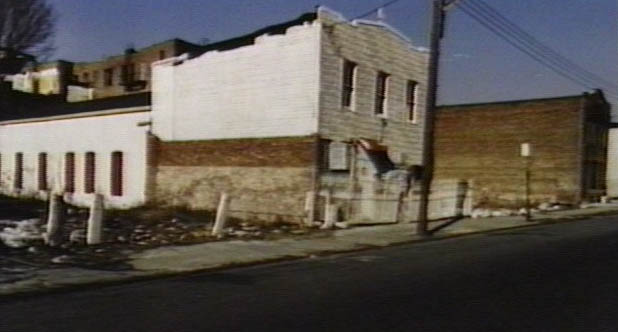 |
Chevre Kesher Achim Anshei Sphard
Address: 450 Hendrix Street Block: 4026 Lot: 26
Founding of Congregation: 1907
Year Constructed: Unknown Demolished: Unk
Notes: On 1929 Plat maps. Thanks to Joann Montgomery for the tax image. Although it is not much to look at, the Star of David is clearly visible on top of the building. Seized via tax lien, 1970. Gone by 1980. Residential construction completed 1991. |
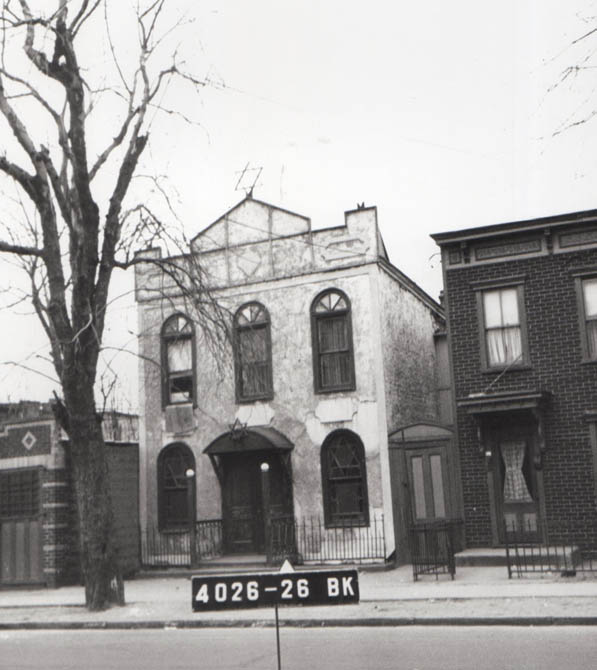 |
|
Beth Sholom Tomchei Halav
Address: 455 Alabama Avenue Block: 3803 Lot: 6
Founding of Congregation: 1909
Year Constructed: Unknown Demolished: Unk
Notes: On 1929 Plat maps. Thanks to Joann Montgomery for the tax image. The property was seized in 1968 as part of the ENY Slum Clearance Program. According to the 1971 docs completing the transaction, the congregation was due a fair amount of money from the city in settlement. It was demolished in the 1970s, but remains a vacant lot today. |
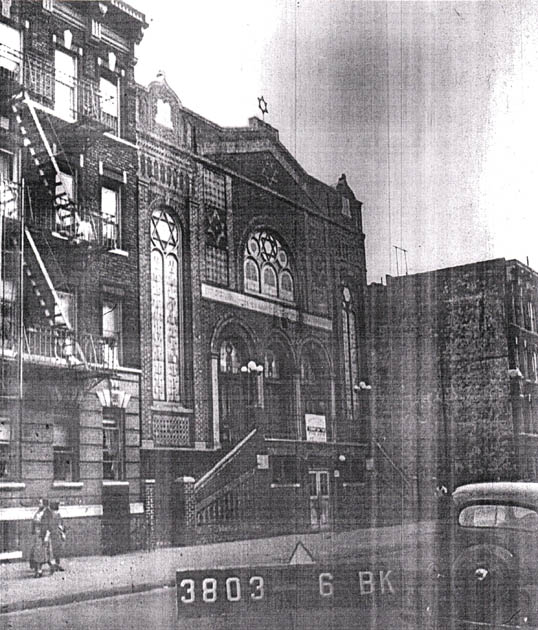 |
|
Congregation Anshei Piask
Address: 420 Hinsdale Street Block: 3800 Lot: 39
Founding of Congregation: 1925
Year Constructed: Unknown Demolished: Unk
Notes: Building sold in 1966, demolished in the 1980s. Phil Kane's family attended this shul and was surprised to discover it's proper name: "We always called it Rabbi Pikus' synagogue. A small Orthodox synagogue where the language in use was Yiddish (which I never really learned). Rabbi Pikus was our next door neighbor on Williams Avenue - Russian-born, came to the US before WW-II, never spoke English. His son was the family translator (as was my father for his parents). I and all my friends took lessons from him at his home and never learned anything other than the bare rote-memory minimum for the Bar Mitzva." |
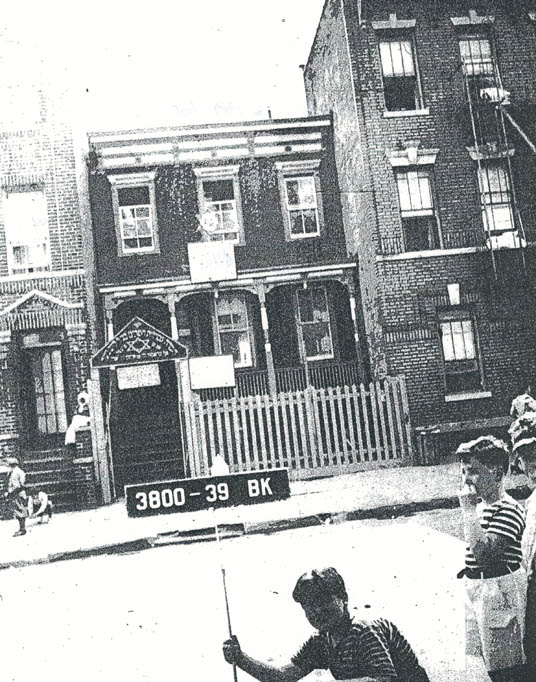 |
|
Congregation Talmud Torah Chodosh
Address: 60 Williams Avenue Block: 3682 Lot: 33
Founding of Congregation: 1920
Year Constructed: 1869 Demolished : circa 1966
This building, just south of Atlantic Avenue, was constructed in 1869 to serve the Williams Avenue Methodist Church congregation. The congregation merged with Andrews Methodist in 1923 and in 1929 a CO was issued to the Congregation Talmud Torah Chodosh. The synagogue sold the property in 1966 and the building was demolished. In 1968 the city opened a brick 5-story welfare office at the location. In 2002, the building was purchased and repurposed as the Trey Whitfield School, a private elementary school. The school, which had been previously using other quarters, opened in 2004. |
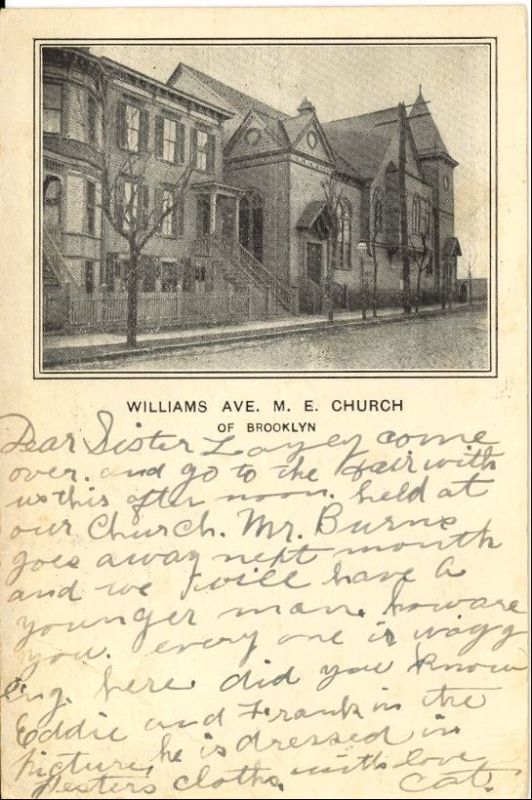 |
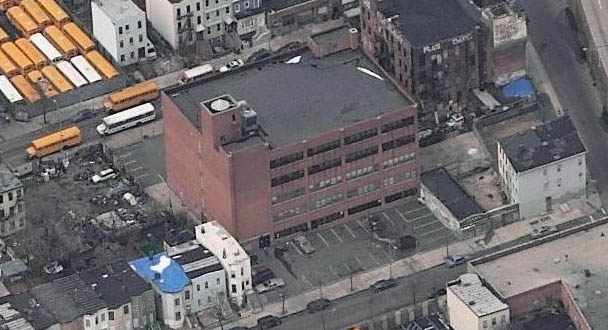 |
Achim Bnai Jacob
Address: 238 Wyona Street Block: Lot:
Founding of Congregation: 1898
Year constructed: 1889 Demolished:Unk
238 Wyona Street sits between Glenmore and Pitkin. This church building was dedicated May 20, 1889 as St. Paul's German Evangelical Lutheran Church, built at a cost of $9,000. The congregation only lasted here about 20 years and the building was sold to the Congregation Achim Bnai Jacob around 1907. In 1921 the congregation built the temple which still stands at 503 Glenmore. Chevre Mishnayes is listed here in 1933, it is evident in the 1941 tax photo it was still serving as a synagogue. No longer standing, the empty land is owned by the St. Augustus Roman Catholic Church. |
 |
|







